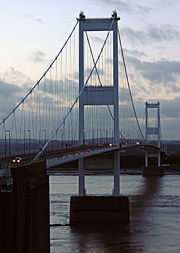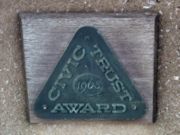Severn Bridge
2008/9 Schools Wikipedia Selection. Related subjects: Road transport
| Severn Bridge | |
|---|---|
 The Severn Bridge seen from the English side of the river. From 1966 to 1996, the bridge carried the M4 motorway. On completion of the Second Severn Crossing the motorway from Aust on the English side to Rogiet was renamed the M48 |
|
| Carries | 4 lane M48 motorway |
| Crosses | Severn Estuary |
| Locale | South West England/South East Wales |
| Design | suspension bridge |
| Longest span | 3240ft (988m) |
| Opening date | 8 September 1966 |
| Toll | Car: £5.30 Van: £10.60 HGV: £15.90 Motorcycle: Free |
| Coordinates | Coordinates: |
The Severn Bridge ( Welsh: Pont Hafren) is a suspension bridge spanning the River Severn from South Gloucestershire, just north of Bristol, to Monmouthshire in south Wales, via Beachley, a peninsula between the Severn and Wye estuaries. It is the original Severn crossing between England and Wales and took five years to construct at a cost of £8 million. The bridge was opened on 8 September 1966 by Queen Elizabeth II, who hailed it as the dawn of a new economic era for South Wales. The bridge was granted Grade I listed status in 1998.
Location
Although the Severn Bridge can only be used for crossing between England and Wales, it is located wholly within England. This is because the "Welsh" end of the bridge itself is located above the Beachley peninsula, which modern boundaries place in England. The border with Wales bissects the Wye bridge, slightly further north along the route.
The ancient Offa's Dyke placed the Beachley peninsula in Wales.
Component structures
The Severn Bridge crossing consists of four structures, which, listed in order from England to Wales, are: the Aust Viaduct, Severn Bridge, Beachley Viaduct and Wye Bridge.
Aust Viaduct
The Aust Viaduct is a twin box girder structure with a concrete deck, which carries the roadway to the first gravity anchorage of the old Severn Bridge. The roadway is then carried over the top of the concrete anchorage to the Severn Bridge.
Severn Bridge
The Severn Bridge is located close to the former Aust Ferry. The bridge is a 5240 feet (1597 metres) long suspension bridge of conventional design, with the deck supported by two main cables slung between two steel towers. The length of the central span (between the towers) is 3240 feet (988 m). The towers rise to 445 feet (136 m) above mean high water and are of hollow box construction. The deck is an orthotropic steel box girder of aerofoil shape with cantilevered cycle tracks and footway supported from the box. The shape of the bridge was determined by the designers Freeman, Fox and Partners following wind tunnel tests for the Forth Road Bridge, after the original wind tunnel model was accidentally destroyed. The sections of the deck were built at Fairfield-Mabey in Chepstow, each 132 tonne section was then floated down the river before being hoisted into position.
Beachley Viaduct
The Beachley Viaduct is also of similar box girder construction as the Severn Bridge but is supported on steel trestles as it crosses the Beachley peninsula. The peninsula contains an army camp, which the bridge crosses.
Wye Bridge
The Wye Bridge is a 1,340 ft (408 m) long cable-stayed bridge, which crosses the border marked by the River Wye into Wales, 2 miles (3 km) south of Chepstow. It consists of a single large cable stayed section with two single-leg pylons supporting the bridge deck from the centre of the roadway. The deck is an orthotropic box girder similar to the Severn Bridge but has a different appearance as it has two sets of cable stays on each of two towers (originally there was only one set of cable stays but these were replaced during the strengthening works in the late 1980s).
Post-construction changes
The Severn Bridge crossing was strengthened and resurfaced in the late 1980s as the weight of traffic grew. The work included the strengthening of the Severn Bridge towers and deck, an extension to the existing Wye Bridge towers and the replacement of the original single stays with two stays. The open structure of the new stays is designed to facilitate maintenance. Most of the strengthening work was inside the deck box or towers and so is not visible. The surfacing is a thin layer (about 35 mm) of mastic asphalt over an acrylic waterproofing membrane.
The road is only two carriageways of two lanes in each direction, and as traffic volumes grew it became a major bottleneck. At its peak, it was carrying 50 000 vehicles a day. The burden of maintenance also became unmanageable, so that by the 1990s a second Severn crossing was necessary. Since the construction of the second bridge, the original crossing carries 15 000 vehicles day, 25% of the total traffic traversing the estuary.
Toll
Shortly after the opening of the Severn Bridge, Anglo-Welsh poet Harri Webb wrote an Ode on the Severn Bridge:
- Two lands at last connected
- Across the waters wide,
- And all the tolls collected
- On the English side.
- Across the waters wide,
The toll is indeed collected on the English side, and only on vehicles travelling westwards from England to Wales, leading some people describing it as a "tax on entering Wales", both in jest, and also as a more serious anti-toll campaign. Originally, tolls were charged in both directions, but the arrangements were changed in the early 1990s to eliminate the need for a set of toll booths for each direction of travel and the potential for traffic waiting to pay the toll backing up onto the bridge itself.
As of January 2008, the toll is £5.30 for a car, increasing to £15.90 for a heavy goods vehicle. Motorcycles and disabled badge holders are exempt from the tolls, although both must stop at the toll booths to have their eligibility confirmed. The tolls for the Second Severn Crossing are the same, although in this case, the tolls are collected on the Welsh side, the longer approach viaducts making queueing on the bridge less of an issue. A system known as the Severn TAG made by Amtech is also in operation, which allows drivers to pay electronically without having to stop at the toll booths. TAGs are available either on a per-trip or a seasonal basis, although only the latter attracts a discount. The cycle path and footpath, which run along either side of the roadway, may be used free of charge.
40 years old - inspections
During its 40th year of operation, the bridge was inspected to check for corrosion of the suspension cables. According to the Highways Agency, the inspection concluded that the bridge needed restrictions on heavy goods vehicles. Such vehicles are now restricted to one lane on the bridge, with weight restriction signs in place. A system of installing a rubber casing on the cables with dry air circulation is to be used on the Forth Road Bridge and a similar system may be implemented on the Severn Bridge, in a move to halt the progress of the corrosion.


